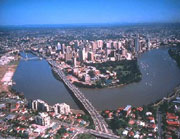THUNDERSNOW 雷雪
|
THUNDERSNOW 雷雪 The conditions required to create thundersnow are most common around lakes (it occasionally accompanies lake-effect snow) and coastal areas. In these places, the sun is able to heat the ground and cause relatively warm and humid columns of unstable air to rise up and form turbulent clouds. 在湖泊周围(偶尔出现湖泊效应降雪)和沿海地区最常出现满足雷雪天气的气候条件。在这些地方,阳光让地面温度上升,导致相对温暖潮湿的不稳定空气柱上升,形成湍流云。 But clouds alone don't make thundersnow. Only if the layer of air between the clouds and the ground is warmer than the cloud cover, but still cold enough to create snow, and the wind shear is pushing the warmer air slightly upwards, does thundersnow form. 但光有云层并不能产生雷雪。只有当云层和地面之间的空气层比云层温度高,但仍冷到足以形成降雪,并且风向切变将温暖的空气稍微向上推时,才会形成雷雪。 The snow can often muffle the thunderclap, meaning that many instances of thundersnow probably go unnoticed. 雪通常会掩盖雷声,这意味着许多时候可能听不到雷声。 SNOWPACK 积雪 When a place has an extended cold season, snow rarely melts between each subsequent snowfall. Some of it will sublimate—or transition directly from a solid to a gas—especially in areas with lots of sunlight and dry wind, but the majority of it will stay present on the ground. When fresh snow falls on top of the old snow, the crystals of the old snow get packed down under the weight of the new cover. Depending on the length of time, snowflake types, and weather conditions between snowfalls, each layer of the snowpack may have a different thickness and density. 在寒冷季节漫长的地区, 每场雪下完之后都不会融化。其中一些雪会升华(直接从固体转变为气体),特别是在阳光充足和风干燥的地区,但大部分雪会留在地面上。当新雪落在旧雪上面,旧雪的晶体会被新雪覆盖的重量压下来。根据每次降雪间隔的时间长度、雪花类型和天气条件,每层积雪可能具有不同的厚度和密度。 FIRN 粒雪 When years and years of snowpack accumulate, that buildup is called "firn." It's much denser than regular snowpack, because of two factors: the partial melting during warmer seasons packs the snow mass closer together; and the new snow falling on top of the ultra-condensed pack pushes the crystals together without melting during the cold season. 当积雪一年又一年堆积起来,就形成了“粒雪”。粒雪比普通积雪密度大得多,这是两个因素导致的:在温暖的季节,一部分雪融化使积雪堆积得更紧密;在寒冷的季节,新雪落在密实的积雪顶部,将晶体推到一起而不融化。 The buildup of firn at high elevations eventually forms glaciers, and replenishes glacial mass to counteract the melting and calving at their lower elevations. The density of firn is between 550830 kilograms per square meter. To put that in perspective, the density of freshly-fallen "powder" snow is around 50 to 70 kilograms per square meter. 高海拔地区的积雪最终形成冰川,并补充冰川物质,以抵消低海拔地区冰川的融化和崩解。粒雪的密度在每平方米550830公斤之间。这是什么概念呢?刚落下的“粉末”雪的密度约为每平方米50至70公斤。 |








